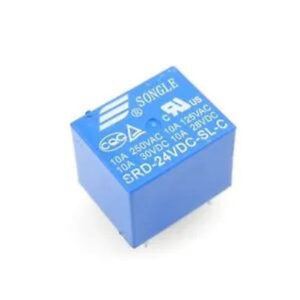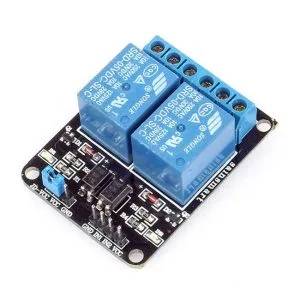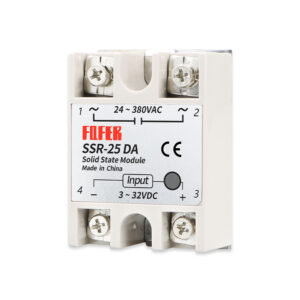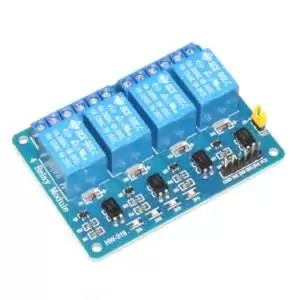General Purpose Relay SPDT (1 Form C) 24VDC Coil 10A Through Hole 5 Pin
The General Purpose Relay SPDT (1 Form C) with a 24VDC coil is a compact yet powerful electromechanical switch designed for efficient and reliable circuit control. Built to handle currents up to 10 amps, this relay is widely used in applications ranging from industrial automation and HVAC systems to home appliances and DIY electronics. Its SPDT (Single Pole Double Throw) configuration allows for switching between two circuits, enabling flexible control over connected devices or loads.
Housed in a durable enclosure and designed for through-hole mounting, the relay easily integrates into printed circuit boards (PCBs), making it an ideal choice for both prototyping and mass production. The 5-pin design simplifies the installation process and ensures solid connectivity, while the internal construction offers dependable operation even under continuous use. The 24VDC coil energizes the relay smoothly, triggering the internal switch to change its contact position—either completing or interrupting the circuit depending on the system’s logic.
This relay also plays a crucial role in protecting sensitive electronic components. By providing galvanic isolation between the control side and the load side, it shields control circuitry from voltage spikes, electrical noise, or surges that might otherwise cause damage. Its robust performance, compact size, and straightforward functionality make it a staple in countless electrical and electronic systems.
Whether it’s used to control lighting, activate motors, or manage power distribution in automated systems, this relay offers a practical and economical solution. With a design focused on durability and consistent switching action, it supports long service life and stable performance across a wide variety of environments. Its versatility, combined with ease of use, makes it a trusted component in both commercial and personal projects.
Features:
- Provides SPDT (1 Form C) configuration: includes both NO (Normally Open) and NC (Normally Closed) contacts.
- Operates at 24VDC, suitable for low-voltage control circuits and microcontroller systems.
- Offers electrical isolation between control and load circuits for added safety.
- Designed with 5-pin through-hole mounting for easy integration into PCB designs.
- Capable of reliable switching of loads up to 10A without significant wear.
- Compatible with popular platforms like Arduino, Raspberry Pi, and PLCs.
- Ideal for use in automation, home electronics, prototyping, and repairs.
- Built to withstand frequent switching cycles with stable performance.
- Compact and durable design, fitting well into various electronic and industrial projects.
- Suitable for controlling lights, motors, alarms, and other electrical loads.
Relay Pin Configuration:
| Pin Number | Pin Name | Description |
| 1 | Coil End 1 | Used to trigger(On/Off) the Relay, Normally one end is connected to 24V and the other end to ground |
| 2 | Coil End 2 | Used to trigger(On/Off) the Relay, Normally one end is connected to 24V and the other end to the ground |
| 3 | Common (COM) | Common is connected to one End of the Load that is to be controlled |
| 4 | Normally Close (NC) | The other end of the load is either connected to NO or NC. If connected to NC the load remains connected before the trigger |
| 5 | Normally Open (NO) | The other end of the load is either connected to NO or NC. If connected to NO the load remains disconnected before the trigger |
Specifications:
- Coil Power : 24V DC
- Pin Out: 5 Pin – Coil – COM – NC – NO
- Nominal Coil Power: 0.36w, 0.45W
- Contact Capacity: 7A 250VAC || 10A 24VDC
- Insulation Resistance: 100MΩ.500VDC
- Operate Time: 15ms/10ms
- Terminal Type: PCB
- Contact Load: High Power
- Product name:: 24V DC Electrical Relay
- Contact Ratings: 10A at 250VAC – 10A at 30VDC
- Contact Material: Silver Alloy
- Size: Miniature
- Protect Feature: Sealed
- Dimensions:1.80cm x 1.50cm x 1.55cm
Applications of Relay:
- Commonly used in switching circuits.
- For Home Automation projects to switch AC loads.
- To Control (On/Off) Heavy loads at a pre-determined time/condition.
- Used in safety circuits to disconnect the load from supply in event of failure.
- Used in Automobiles electronics for controlling indicators glass motors etc.
- Prototyping and DIY Projects.
- Time and Temperature Control.
- Switching High Voltage Circuits.
2D model of the Relay:

Datasheet:
General Purpose Relay SPDT (1 Form C) 24VDC Coil 10A Through Hole 5 Pin













Reviews
There are no reviews yet.